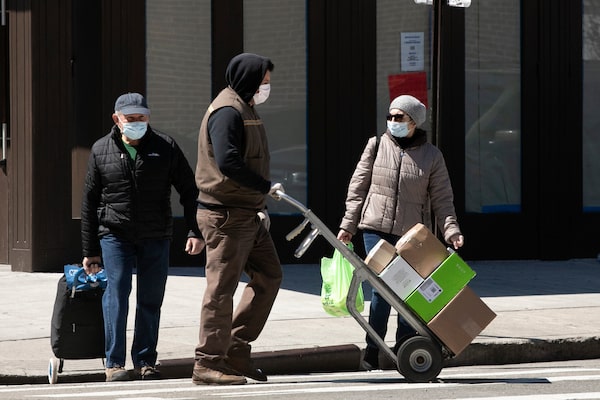
The U.S. Centers for Disease Control and Prevention urged Americans – A UPS driver and two pedestrians seen here in New York City on April 6, 2020 – to wear home-made masks.Mark Lennihan/The Associated Press
“It’s a not a recommendation, … It’s a permissive statement,” Dr. Theresa Tam, Canada’s Chief Public Health Officer, said Monday.
Never mind the bureaucratic hair-splitting.
Canadian public-health officials are now saying that wearing a mask in public is a good idea to help prevent the spread of coronavirus – or at least not a bad idea.
No matter how much they back into it, that’s a pretty significant policy change after years of saying “masks don’t help.”
Policy-makers should own it. There are good reasons policies are shifting, as well as some limitations to the non-recommendation, slash, permissive statement.
The advice about masks is changing because our knowledge of the coronavirus and how it spreads is evolving. That’s how science works.
The Public Health Agency of Canada is not alone in adapting. The U.S. Centers for Disease Control and Prevention has been much more clear in its messaging, urging Americans to wear home-made masks. Even the World Health Organization, which has long been unenthusiastic about masks, has shifted its views.
“We can certainly see circumstances in which the use of masks, both home-made and cloth masks, at the community level may help with an overall comprehensive response to this disease,” Dr. Michael Ryan, executive director of the WHO’s health emergencies program, said on Friday.
These statements, no matter how cautious, are an acknowledgment that there is likely more benefit than harm from mask-wearing. Still, they are a far cry from rules for mandatory masks in public, which countries such as Austria, Slovakia and the Czech Republic have instituted.
The greatest risk of infection comes from interacting with someone who is sick with COVID-19. That hasn’t changed. But there is growing evidence that both pre-symptomatic and asymptomatic infection can also occur – meaning that someone can spread the illness without feeling sick themselves.
The current rules are that people who are sick and those who have travelled outside the country must stay home. People who are not sick can do things such as grocery shopping, going to work in essential services or even going for a walk.
In some circumstances, physical distancing can be difficult.
Coronavirus guide: Updates and essential resources about the COVID-19 pandemic
‘Can I take my kids to the park?’ And more coronavirus questions answered by André Picard
If there is a possibility, however remote, that you could infect others and wearing a mask in public could reduce that risk, even a bit, then why not?
The reason officials are still so reluctant to say “wear a mask” in as many words is that there are many nuances and a real fear of unintended consequences.
One of the dangers of promoting mask-wearing is that the public will see it as a substitute rather than a complement to other measures such as isolation, physical distancing and handwashing.
“It doesn’t mean you can back off of physical distancing or hand hygiene,” Dr. Tam said.
The other fear is that people will purchase (or steal) surgical masks, which are already in desperately short supply in hospitals and other high-risk settings.
That is why Dr. Tam stressed that the public should wear “non-medical” masks. Again, that advice could have been much more explicit.
Many “masks for all” advocates use the rhetorical argument: “If doctors wear face masks, why shouldn’t I?”
The answer is that doctors (and nurses and other health-care workers) are at much greater risk. They are in direct contact with sick people. They get coughed and sneezed on and a mask protects them against droplet-borne diseases.
In the real world, such as at the supermarket, the risks of coronavirus are a lot less pronounced than in hospitals and so are the benefits of wearing a mask.
In addition to telling people not to wear surgical masks, we should be telling them to make their own and teaching them how to wear them properly.
The public needs to understand as well that mask-wearing can prevent them from infecting others more than it can protect the wearer from infection.
The inconvenient truth is that improper mask-wearing (covering your mouth and not your nose, or not having a snug enough fit), and lack of attention to donning and doffing technique, can actually increase instead of decrease the risk of infection.
There is some evidence that people wearing masks touch their faces more, and some that it discourages face-touching.
The evidence for mask-wearing as a means of infectious disease prevention remains mixed at best.
Increasingly, however, making and wearing a mask in public is becoming a demonstration of civic-mindedness, a public acknowledgment of the risks coronavirus poses, and a fitting symbol for the new normal.
Christopher Mio and Meghan Hoople found themselves jobless and wanting to help in the wake of COVID-19 isolation in Toronto. After flyering their neighbourhood with a free-of-charge offer, they received an outpouring of support and requests from people in need.
The Globe and Mail
Sign up for the Coronavirus Update newsletter to read the day’s essential coronavirus news, features and explainers written by Globe reporters.
 André Picard
André Picard